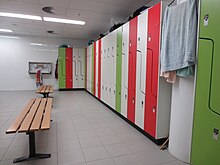Changing room
Changing-rooms are provided in a semi-public situation to enable people to change clothes with varying degrees of privacy.Separate changing rooms may be provided for men and women, or there may be a non-gender-specific open space with individual cubicles or stalls,[1] as with unisex public toilets.Newer locker rooms may be automated, with robotic machines to store clothes, with such features as a fingerprint scanner to enroll and for later retrieval.The same wristband that unlocks the lockers can be used to purchase food and drinks and other items in the water park.[2] Émile Zola noted their existence in his novel Au Bonheur des Dames (1883), and that they were then forbidden to men.[clarification needed][2] In any case, Buster Keaton worked in one in an American 1928 silent comedy The Cameraman.[2] Some homes may have dedicated rooms solely for the purpose of dressing and changing clothes, typically with fitted wardrobes.[5][6] Changing room operators frequently post signs disclaiming responsibility for stolen items, which can discourage but not eliminate claims for negligence.







Changing room (disambiguation)provided for men and womenunisex public toiletsYonge–Dundas Squarebathing suitsJyväskyläFinlandKeangnam Hanoi Landmark Towerlockerscommunal showersLockingcombination locksweatersdepartment storesÉmile ZolaAu Bonheur des DamesHenri GervexJeanne PaquinBuster KeatonsilentThe CameramanLes Trois FrèresboudoircabinetlabyrinthUnisex changing roomsVirtual dressing roomWayback MachineInstitut d'études politiques de LilleTelevision productionAudienceBroadcast networkHistory of televisionTelevision crewTelevision showTelevision studioCentral apparatus roomMaster control roomNetwork operations centerProduction control roomStage (theatre)Transmission control roomCelebrityDirector of network programmingNews presenterSports commentatorNews directorShowrunnerCasting directorCostume designerTV directorAssistant directorLocation managerMake-up artistProduction designerResearcherSet designerTV producerTelevision program creatorExecutive producerLine producerProduction managerWriterHead writerScreenwriterScript editorStory editorAudio engineerBoom operatorCamera operatorCinematographerVideographeroperatorStudio floor managerGraphics coordinatorStage managergafferKey gripDolly gripUnit production managerProduction assistantStunt coordinatorTechnical directorTelevision directorBroadcast engineeringSound editorFoley artistComposerColoristEditorPublicistVisual effects artistBeauty pageantBroadcasting of sports eventsTV commercialsEvent televisionGame showLive televisionVariety showPolice crime dramaReality televisionTelevision filmDocumentary filmMockumentaryTelevision specialAnimated seriesLimited-run seriesMiniseriesProcedural dramaSerialSitcomSoap operaTalk showLate-night talk showBreaking newsDebate showNews broadcastingPolitical commentaryTraffic reportsWeather forecastsAudience measurementList of television awardsTelevision content rating systemTelevision criticismBroadcast reference monitorCharacter generator
